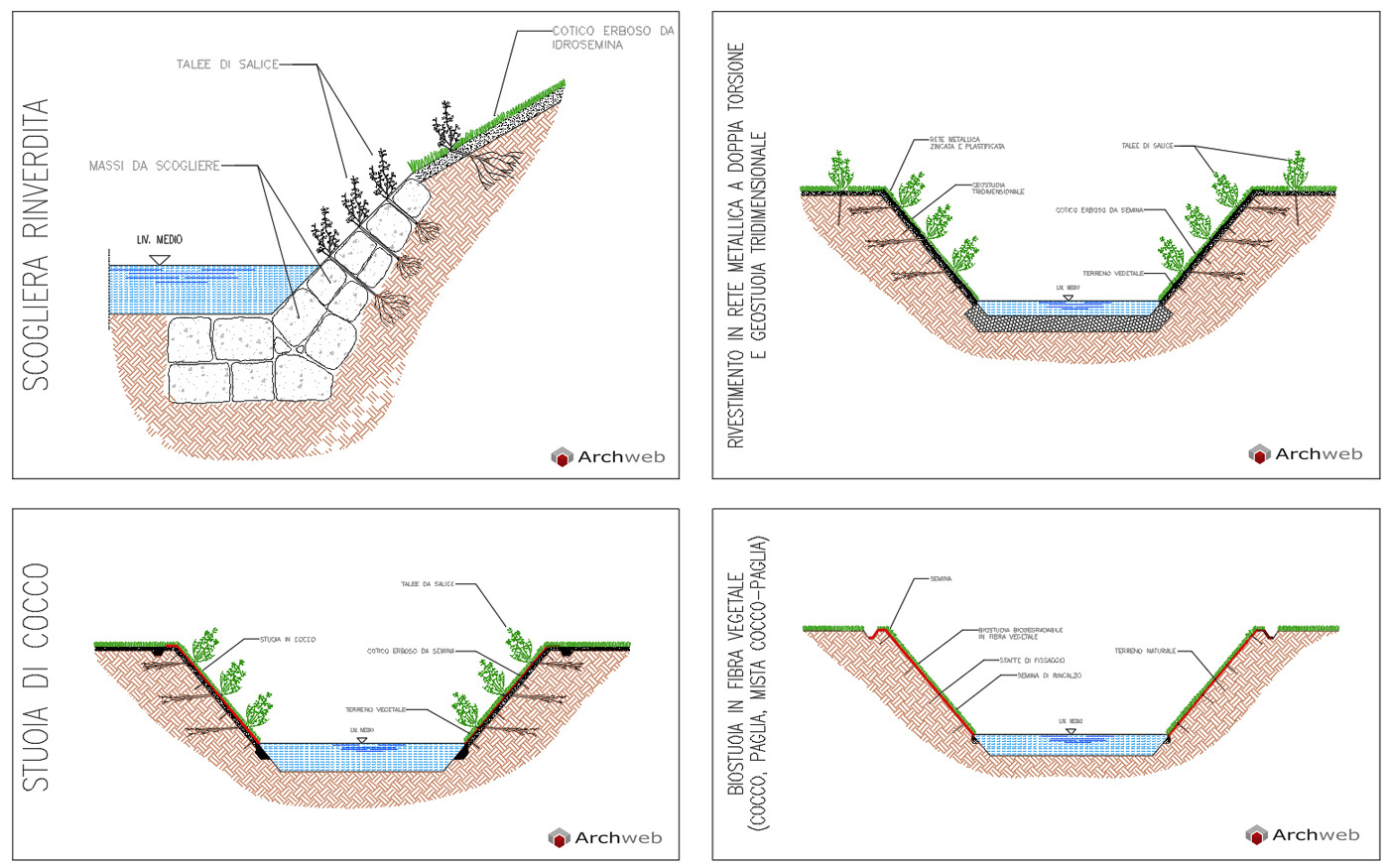Renaturalization of water courses
Hydraulic installation interventions

The hydrogeological instability and the renaturalization of waterways
The hydrogeological instability includes all those processes that can cause soil degradation. Usually these actions are caused both by meteorological phenomena and by human activities, such as overbuilding.
The hydrogeology deals with the study of groundwater, also related to surface water.
The phenomena that include hydrogeological instability are water erosion (landslides), floods, avalanches, deforestation, the illegal building, the abandonment of high ground, the continuous excavations, the extraction of hydrocarbons and water from the subsoil, invasive interventions and not eco-sustainable on the waterways.
In Italy it is a fairly significant problem, it varies from area to area and the consequences of the process are different. The problem is widespread on the national territory, especially due to the geological conformation, determined by a complex orographic surface and by hydrographic basins of limited size.
Weather conditions can sometimes take on a dangerous character, especially if they occur with particular intensity; in fact it is possible that they can cause considerable damage to things and people. However, a distinction must be made between risks caused directly and indirectly. The former can be caused by thunderstorms, winds, fog, snow and frosts, therefore by atmospheric phenomena. Indirect risks are caused by the union of meteorological processes with aspects of the territory, linked to human activities: they concern for example heavy or abundant rains, combined with particular conditions of a territory, which can cause landslides or floods (hydrogeological or hydraulic risk). High temperatures, low humidity and strong winds, combined with the characteristics of the soil, can determine the risk of fires. Or even heavy snowfalls in the mountains, combined with significant winds and slopes can generate avalanches.
Naturalistic engineering
With the term of Naturalistic Engineering we refer to those techniques that are used to reduce the risk of soil erosion during consolidation works. The techniques of Naturalistic Engineering represent an excellent solution, especially for the creation or restoration of a degraded natural environment, through the use of native vegetation and the hydrogeological arrangement of the territory, the recovery of the natural habitat and the landscaping of artifacts. and infrastructure.
The re-naturalization interventions they are more and more common in our country, especially in those environments where the state of alteration linked to river courses is a problem. These works are usually dealt with to secure nearby urban areas.
All the works of Naturalistic Engineering are made with natural materials such as:
- plant materials such as seeds, plants and shrub species, roots and plant parts of woody plants, turf;
- inert organic materials, such as timber, jute nets, straw, hay and biodegradable organic materials;
- synthetic materials, which better protect the soil giving the soil greater stability, such as grids, nets and fabrics together with nylon, polyethylene and chemical adhesives;
- generic inert materials, such as stones, wire, iron, galvanized nets.
When dealing with a Naturalistic Engineering operation, there are some recurring elements that are used, which differ from more traditional interventions.
It begins with the analysis of the topographic and climatic characteristics of each surface subject to intervention, the soil is then examined in relation to the chemical, physical and hydrological, and geomorphological characteristics; a phase of floristic and vegetative study follows, paying attention to the possible presence of rare botanical species and seeds, and also evaluating the biotechnical characteristics of the species themselves, their capacity and speed of growth, of adaptation to the environment, and also to the possible availability on the market.
We then move on to assessing any presence of existing infrastructures. After this first analysis we arrive at the study of the use of the new materials that will be used, with the relative selection of the plant species to be used and possible grassy sod transplants. Then the type of environmental and naturalistic reintegration is evaluated, trying to improve the area by masking the artificial elements of the work.
Among the advantages of the methods used by Naturalistic Engineering are the reduced costs for the construction and maintenance, the creation of natural habitats, the conservation and improvement of the landscape.
Among the disadvantages are the periodic and continuous maintenance, the limits of the size of interventions and the times that are not always immediate and fast.
All the operations and processes studied by the Naturalistic Engineering have the objective of protecting watercourses: rivers are not simple river channels; since the past rivers have been the seat of the birth of towns, civilizations and cities, since they are natural axes of water supply but also function as means of navigation and transport. Waterways are resources to be exploited.
Hydraulic arrangement interventions
Planning hydraulic interventions along a river course must be the result of a study of the places where one should not intervene, since one wants to give naturalness to the river.
The hydrogeological settlement operations must guarantee the storage of the continuity of water courses, the maintenance of the diversification of micro-environments, the naturalness of the morphology of the river beds and banks, the biological productivity of the waterways, the landscape value, the use of the waterways themselves.
Naturalization of the banks and bank defenses ( see dwg drawings )
One of the most important hydraulic operations concerns the naturalization of the banks.
The paths of the river courses are hampered both by the shape and by the surface of the section of the riverbed itself (bends, curves, riverbed irregularities…).
The transformation of a watercourse involves the redefinition of the riverbed, and this change is carried out by trying to rectify the stream (which will therefore increase its speed), making the surfaces of the seabed and banks smooth, but also conforming the outflow sections.
The interventions in the riverbed cause a significant impact on the life of macro organisms since they cannot avoid the alteration of the habitat. The main damage is caused by construction vehicles and deposits of materials on the seabed (damage to fish fauna).
The processes of reshaping of the riverbed of the river must allow adequate flow; the possible widening of the river bed leads to a dispersion of water over a naturally larger surface, causing a consequent slowing of the current; during the lean periods of the river this can be harmful to the activity of the fish fauna, since the seabed is poor and sparse, with the presence of medium-sized granular boulders. On the contrary, during flood periods and in the absence of adequate shelters, the solid transport of particle size can be fatal for organisms living in rivers.
Therefore, in order to avoid these disasters, but at the same time widening the section of the river, the leveling of the riverbed should be avoided, trying to differentiate between low and flood periods. In the first case, an attempt is made to maintain the original and natural riverbed, while in the second case the floodbase must be obtained at a higher level, as it receives considerable flow. The banks must be re-naturalized with indigenous vegetation.
To implement the transformations of naturalization of the banks are made the bank defenses: it is a sort of coating of the external banks, carried out with materials such as boulders, concrete prisms, walls, gabions, etc. .
Among the bank defense works we find the ballast and prismate, made with boulders of different sizes; the spaces between the boulders can be free or closed with different cements; however, dry cliffs are preferable, without concrete material, in fact the spaces allow greater continuity between the river and the aquifer, since they reduce the development of plant roots and also favor the diversification of ichthyofauna.
The cliff is also a bank defense work that is used to protect inhabited areas or relevant buildings and roads.
The gabions they are usually used in association with boulders and concrete prisms. They consist of metal mesh cages filled with coarse gravel and provide shelters for small organisms. They also allow easy vegetation development.
The walls they allow the preservation of artifacts and act as artificial banks for waterways.
They are made with stones, bricks and concrete. The construction of walls is not recommended, as they limit the development of plants and cause a negative impact on fish fauna, except for artificial canals, which must avoid continuous water losses.
The double-walled piling They are the shore defense structures, and are inserted in an appropriate manner in the landscape also from the landscape point of view, because they are composed by using natural materials and local vegetation. This type of structure is mainly used in waterways where the speed of the current is limited. The drawback is the degradation of the timber, and to delay this problem it is advisable to support the piling over a cliff, thus avoiding that the wood is always submerged under water. Another disadvantage is the obstacle that this method causes to the fish fauna, since it is separated into many isolated nuclei. When installing structures of this type, attention must be paid to some considerations: the flow speed must be low, the fish must be allowed to overcome the barriers, it is advisable to proceed with the renaturalization of the bank to recreate a suitable natural habitat.
© Reserved reproduction / It is possible to share with a link to the page
 Naturalistic engineering and slope consolidation
Naturalistic engineering and slope consolidation
 Naturalistic management manual of irrigation canals
Naturalistic management manual of irrigation canals
 Ichthiocompatible hydraulic interventions guidelines
Ichthiocompatible hydraulic interventions guidelines
 General study for the implementation of hydrogeological reorganization interventions
General study for the implementation of hydrogeological reorganization interventions
































































